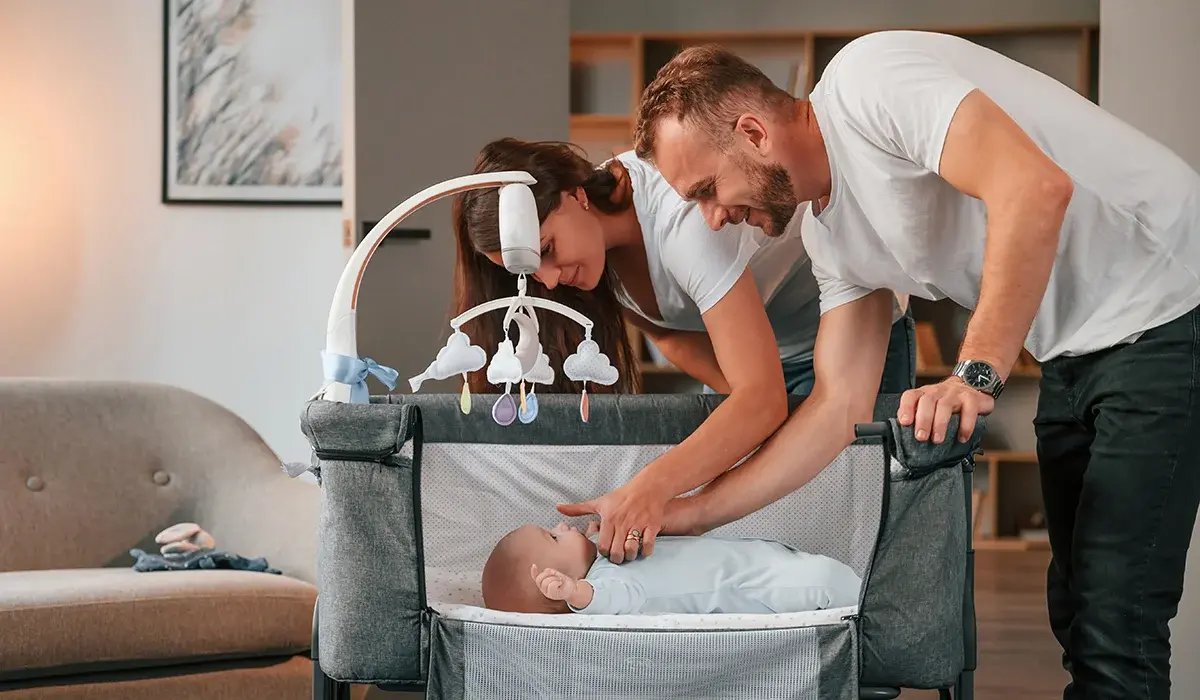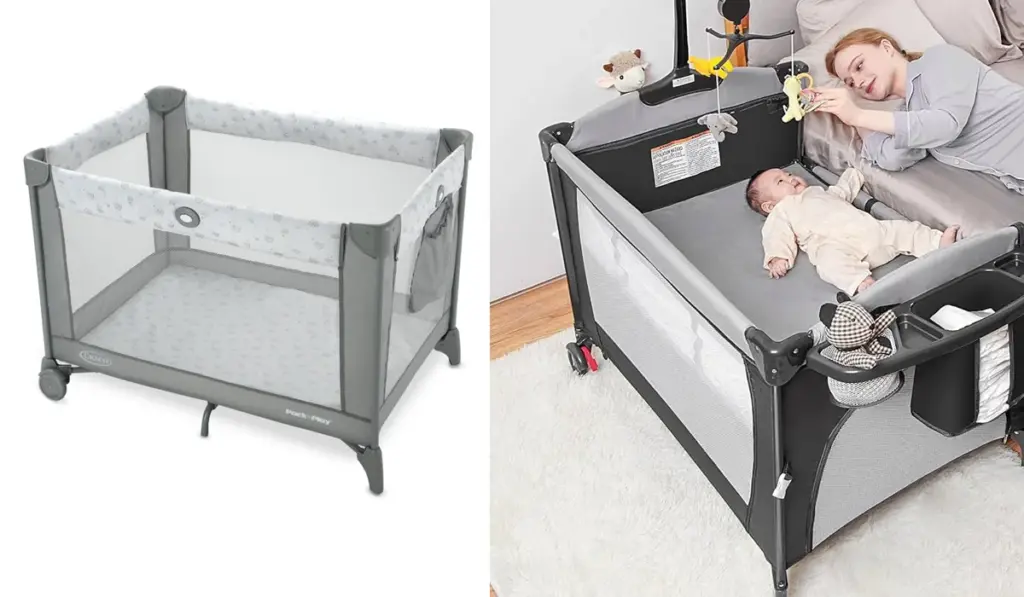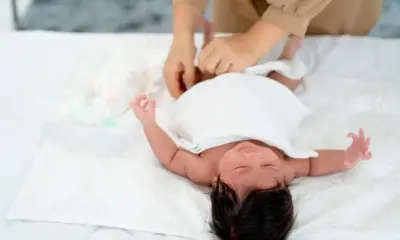Sleep
How Long Can a Baby Safely Sleep in a Pack ‘n Play?

Pack ‘n Play Sleep Safety: Tips for Parents
When it comes to setting up a safe sleep environment for your baby, understanding Pack ‘n Play sleep safety is essential. Many parents rely on a Pack ‘n Play as a versatile piece of baby gear for travel and home use. But is it safe for your little one to sleep in it overnight, and for how long? In this article, we’ll dive into the key safety tips, comparisons with cribs, and how to make the Pack ‘n Play a safe sleep space for your baby. Let’s explore all aspects of Pack ‘n Play sleep safety to ensure peace of mind for parents.
What Is a Pack ‘n Play?
A Pack ‘n Play is a portable play yard that serves as a safe space for your baby to sleep, play, and even be changed. It’s lightweight, compact, and can easily be folded for travel. The convenience it offers, combined with its multifunctionality, makes it an excellent choice for busy parents. Some Pack ‘n Plays even include additional features like changing stations and detachable bassinets, making them an ideal choice for various situations.
Is It Safe for a Newborn to Sleep in a Pack ‘n Play?
Yes, it is perfectly safe for your newborn to sleep in a Pack ‘n Play as long as it adheres to safety guidelines. These play yards are designed with safety in mind and meet the Consumer Product Safety Improvement Act of 2008 (CPSIA) standards. Many Pack ‘n Plays come with removable mattresses that can be inserted to provide a comfortable sleep surface. Be sure to select a Pack ‘n Play that meets all the required safety standards and verify this information on the manufacturer’s website or product packaging.
To ensure your newborn’s safety, always follow the recommended guidelines for height and weight. The Pack ‘n Play is suitable for babies who are under 35 inches tall or weigh less than 30 pounds. After your baby exceeds these limits, it’s time to transition to another sleeping arrangement.
Pack ‘n Play vs Crib: Key Differences

Courtesy of Amazon
While both Pack ‘n Plays and cribs provide safe spaces for babies to sleep, they differ in several ways. Understanding these differences can help you decide which option is best for your baby.
Portability
One of the main differences is portability. Pack ‘n Plays are designed for easy transport, as they are lightweight and foldable. They are perfect for trips or moving around the house. In contrast, cribs are larger, heavier, and typically not as easy to move.
Size and Mattress
Pack ‘n Plays are smaller than cribs, which means the mattress is also smaller. This can limit your baby’s space as they grow. While a Pack ‘n Play mattress is usually thinner and firmer than a crib mattress, it is designed to meet safety standards by reducing the risk of suffocation and entrapment. Cribs, on the other hand, offer more space and usually come with thicker, softer mattresses.
Longevity of Use
A Pack ‘n Play is an excellent option for newborns and can be used for short-term sleeping, but as your baby grows, you may find it’s no longer as comfortable. A crib provides a more permanent solution and can accommodate your baby for a longer period, even into toddlerhood.
Versatility
A Pack ‘n Play is more versatile than a crib. It can be used as a changing station, a playpen, and even as a bassinet for younger babies. Cribs, however, are typically dedicated solely to sleeping.
When Should Your Baby Stop Sleeping in a Pack ‘n Play?
Safety guidelines suggest that you should stop using a Pack ‘n Play for sleep once your baby exceeds 35 inches in height or weighs more than 30 pounds. It’s important to monitor your baby’s growth and transition them to a more appropriate sleep space when necessary. This ensures they have enough space to move around safely and sleep comfortably.
How to Make Pack ‘n Play a Safe Sleep Environment?
Creating a safe sleep environment is critical to your baby’s health and safety. Here are some key tips to follow when setting up a Pack ‘n Play for sleep:
1. Firm Mattress
Ensure the mattress is firm and fits snugly in the Pack ‘n Play. There should be no gaps between the mattress and the sides of the play yard, as this could pose a suffocation risk.
2. Always Place Your Baby on Their Back
It’s crucial to place your baby on their back when they sleep in a Pack ‘n Play. This position has been shown to reduce the risk of Sudden Infant Death Syndrome (SIDS).
3. Avoid Loose Bedding and Pillows
Never place pillows, blankets, or stuffed animals in the Pack ‘n Play while your baby is sleeping. Loose items can increase the risk of suffocation. The American Academy of Pediatrics (AAP) advises against the use of any soft bedding in an infant’s sleep environment.
4. Use the Bottom Play Area for Sleeping
Avoid using the changing station or the detachable bassinet for sleeping once your baby begins to roll over. The Pack ‘n Play’s bottom play area with mesh sides is the safest place for your baby to sleep.
5. Room Sharing
The AAP recommends room-sharing with your baby for the first 6 to 12 months. Keep the Pack ‘n Play in your room for easy access during nighttime feedings and diaper changes. This can also help reduce the risk of SIDS by as much as 50%.
6. Secure the Pack ‘n Play Properly
Before placing your baby in the Pack ‘n Play, ensure it is set up correctly and locked into place. Double-check that all parts are secure to prevent accidents.
Frequently Asked Questions
1. Can my baby suffocate in a Pack ‘n Play?
Yes, if safety guidelines are not followed, there is a risk of suffocation. Avoid placing any extra bedding or pillows in the Pack ‘n Play, as these can obstruct airflow and pose a suffocation risk.
2. Can my baby sleep in a Pack ‘n Play without a mattress?
It is safe for your baby to sleep on the thin pad that comes with the Pack ‘n Play. However, if you want to make the surface more comfortable, you can add a firm mattress specifically designed for use with a Pack ‘n Play.
3. Why are Pack ‘n Play mattresses hard?
The firmness of a Pack ‘n Play mattress is important for safety. It helps prevent suffocation and reduces the risk of entrapment by minimizing gaps between the mattress and the play yard walls.
4. Can a Pack ‘n Play be used for overnight sleep?
Yes, as long as the Pack ‘n Play meets safety standards and is set up properly, it is safe for overnight sleep. Always ensure that the mesh sides are intact, the mattress is firm, and there are no loose items in the play area.

Conclusion: Ensure Safe Sleep with Pack ‘n Play
Investing in a Pack ‘n Play for your baby can be a great choice for portable and versatile sleeping arrangements. However, it’s essential to follow Pack ‘n Play sleep safety guidelines to protect your baby. By adhering to safety standards and creating a safe sleep environment, you can rest easy knowing your baby is comfortable and secure.
Explore more safety tips and guidelines for baby care on our website.












